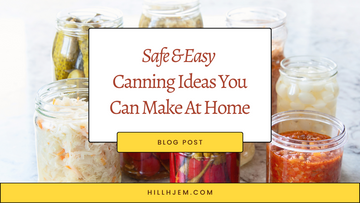
Canned goods are a lifesaver in the kitchen. They're shelf-stable, convenient, and perfect for whipping up quick meals.
Have you tried making your own canned delights? It's a surprisingly rewarding and safe process, allowing you to control ingredients and enjoy the satisfaction of a homemade pantry.
Safe and Delicious Options You can Safely Can at Home
1. Jams & Jellies
Make jams and jellies from berries (strawberries, raspberries, blueberries), stone fruits (peaches, plums, nectarines), or citrus (grapefruit, oranges). Spread them on toast, pastries, or even crackers. You can add herbs like mint or spices like cinnamon for extra flavor.
2. Fruit in Syrup
Can peaches, pears, or apples in a light syrup for a delicious treat. Enjoy them on their own, add them to yogurt parfaits, or use them in desserts like cobblers or pies.
3. Salsa
Make your perfect salsa, from mild to fiery, using fresh tomatoes, peppers (bell peppers, jalapenos), and onions. You can also try with different ingredients like corn, black beans, or tropical fruits (mango, pineapple). Explore using fresh herbs like cilantro or chopped fresh chiles for an extra kick. Perfect for chips, tacos, or even add a dollop to omelets or scrambled eggs for a flavor boost.
4. Tomatoes & Sauces
Diced tomatoes, crushed tomatoes, or even your signature pasta sauce – all can be safely canned for a base of countless future meals. Homemade canned tomatoes offer a burst of fresh flavor compared to store-bought varieties, and you can control the level of seasoning to perfectly suit your taste preferences.
5. Pickled Vegetables
From classic cucumbers to colorful peppers (bell peppers, jalapenos) and even green beans, pickling vegetables adds a tangy twist and extends their shelf life. Explore different pickling solutions using flavored vinegars (red wine vinegar, rice vinegar) or herbs and spices (dill, mustard seeds, garlic) to create a variety of pickling profiles. Pickled vegetables are not only delicious on their own but also add a delightful element to salads, sandwiches, or cheese plates.
6. Chutneys
Unlike regular jams, chutneys mix sweet fruits like mango or apples with savory veggies like onions and peppers. Throw in some spices like cumin and coriander, and you've got a sweet and spicy sauce that livens up any curry or grilled meat.
7. Candied Fruits & Vegetables
Candied fruits like cherries or ginger add a gourmet touch to desserts or charcuterie boards. Candied vegetables like onions or peppers offer a sweet and savory flavor combination that can elevate salads, sandwiches, or even be enjoyed on their own.
8. Soup Mixes
Dehydrated vegetables, beans, lentils, and spices can be combined and canned to create a quick and flavorful homemade soup base. This is a perfect way to utilize leftover bits and pieces of vegetables and create a pantry staple for those busy weeknights. Experiment with different flavor profiles - Italian with vegetables, beans, and dried herbs or Asian-inspired with dehydrated mushrooms, ginger, and chilies.
9. Dried Fruits & Vegetables
While not technically canning, dehydrating fruits and vegetables is another excellent way to preserve the season's bounty. Dehydrated fruits like apples, mangoes, or berries are a healthy and portable snack, perfect for lunchboxes or hiking adventures. Dehydrated vegetables like mushrooms, peppers, or onions can be rehydrated and used in future recipes, adding a burst of concentrated flavor.
Important Note: Always refer to trusted resources for tested recipes and safe processing times for specific foods and canning methods.
Foods Not Recommended for Home Canning:
- Low-acid foods: These are foods with a pH level greater than 4.6. They include most vegetables (except for tomatoes with added acid), some fruits (figs, melons), milk, all meats, fish, and seafood. Botulism spores can germinate and grow in low-acid foods that are not canned properly at high temperatures. Pressure canning is the only safe way to can low-acid foods.
- Dairy products: Milk, cream, cheese, yogurt, and other dairy products can curdle or spoil during canning, and can harbor bacteria that can cause illness.
- Fats and oils: Oils, such as olive oil or vegetable oil, can turn rancid when canned. Fatty foods, like sausage or bacon, don't can well because fat can interfere with sealing jars.
- Dense foods: Dense foods, such as refried beans, stuffing, and whole grains, can be difficult for heat to penetrate throughout, creating an environment where harmful bacteria can grow.
- Baked goods: Cakes, cookies, breads, and other baked goods don't can well because they can become soggy or lose their texture.
- Baby food: Commercial baby food is already shelf-stable and don’t need to be canned at home. If you want to can your own baby food, consult a reliable source for tested recipes and procedures.
Note: If you are unsure whether a particular food is safe to can, it is always best to err on the side of caution and not can it.
There you have it! No more mystery ingredients or sad, wilted veggies lurking in your pantry. Home canning lets you turn fresh finds into delicious jams, pickles, and more – all without breaking the bank or spending hours slaving over a hot stove.
Remember, safety is key. Always refer to trusted resources for tested recipes and processing times specific to your chosen foods and canning methods.
Happy canning, and enjoy the delicious rewards of your handiwork!




